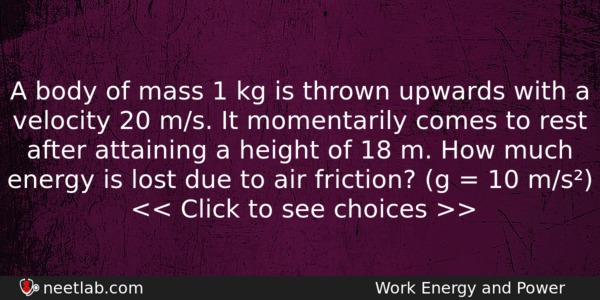| ⇦ | 
| ⇨ |
A body of mass 1 kg is thrown upwards with a velocity 20 m/s. It momentarily comes to rest after attaining a height of 18 m. How much energy is lost due to air friction? (g = 10 m/s²)
Options
(a) 30 J
(b) 40 J
(c) 10 J
(d) 20 J
Correct Answer:
20 J
Explanation:
When the body is thrown upwards. its K.E is converted into P.E. The loss of energy due to air friction is the difference of K.E and P.E
1/2 mv² – mgh = 1/2 x 1 x 400 – 1 x 18 x 10
= 200 – 180 = 20 J
Related Questions: - The potential energy of a weightless spring compressed by a distance D is proportional
- A car moving with a velocity of 36 km/hr crosses a siren of frequency 500 Hz.
- The position vector of a particle R as a function of time is given by
- Two capacitors 3μF and 4μF, are individually charged across a 6 V battery.
- A solid sphere of mass M, radius R and having moment of inertia about an axis passing
Topics: Work Energy and Power
(94)
Subject: Physics
(2479)
Important MCQs Based on Medical Entrance Examinations To Improve Your NEET Score
- The potential energy of a weightless spring compressed by a distance D is proportional
- A car moving with a velocity of 36 km/hr crosses a siren of frequency 500 Hz.
- The position vector of a particle R as a function of time is given by
- Two capacitors 3μF and 4μF, are individually charged across a 6 V battery.
- A solid sphere of mass M, radius R and having moment of inertia about an axis passing
Topics: Work Energy and Power (94)
Subject: Physics (2479)
Important MCQs Based on Medical Entrance Examinations To Improve Your NEET Score
18000+ students are using NEETLab to improve their score. What about you?
Solve Previous Year MCQs, Mock Tests, Topicwise Practice Tests, Identify Weak Topics, Formula Flash cards and much more is available in NEETLab Android App to improve your NEET score.
Share this page with your friends

Leave a Reply